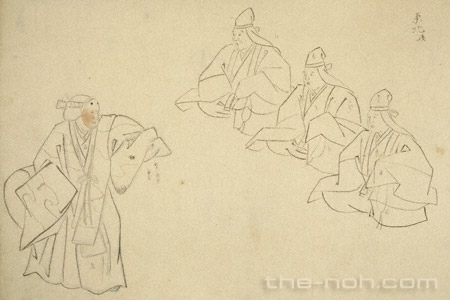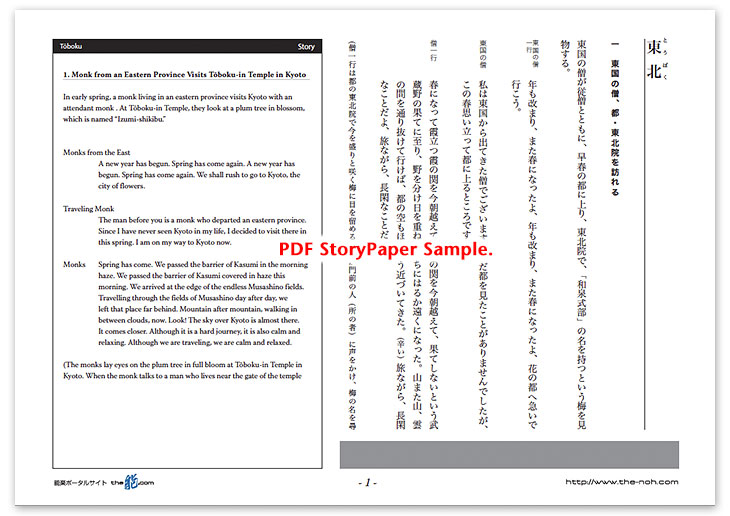
 Toboku
Toboku

![]()
In early spring, a Buddhist monk attended by another monk traveled to Kyoto from an eastern province. They arrive at Tōboku-in Temple, where a splendid plum tree blooms. As they watch the tree in wonder, they learn from a person who lives near the gate of the temple that the plum tree is named “Izumi-shikibu.” Then, a woman appears and corrects them; the tree should be named “Kōbunboku” or “Ōshukubai.” She narrates the story that Lady Izumi-shikibu planted the plum tree. Although the monk and the woman exchange more words, she eventually hides behind the plum tree illuminated scarlet by the sunset glow. She then disappears.
The monk talks to the person living in the temple town again and hears about the history of the Tōboku-in Temple and the story of Lady Izumi-shikibu. He advises the monk to cordially console the soul of the woman whom the monk just met as she must be the ghost of Lady Izumi-shikibu.
While the monk recites the Lotus Sutra to pray for the woman, the ghost of Izumi-shikibu appears. She reveals that she has already become a Bodhisattva of singing and dancing and talks about her memory associating her tie made by Buddha. After preaching the virtues of Japanese poetry and the preciousness and wonderfulness of Buddha’s Law, she dances. Then, the ghost of Lady Izumi-shikibu is embarrassed about reminiscing of past intimate relationships she used to enjoy. She bids farewells and enters a cabin. When the monk sees her enter the room, he awakens from his dream. Lady Izumi-shikibu disappears now.
![]()
This Noh drama, which was once called “Nokiba no Ume (The Plum Tree near the Eaves)” in ancient times, is filled with the grace and sophistication comparable to that of the fragrance of the plum blossom in early spring. Also, since it features Lady Izumi-shikibu, a talented poet who occupied a significant position in the world of Heian period tasteful court literature, this piece makes you feel the elegance of a cultural salon in the royal court in the Heian era.
Although the storyline is neither dramatic nor remarkable, this piece describes a deep philosophy which lauds the virtues of Japanese poetry and teaches the preciousness and wonderfulness of the Buddha’s Law. This piece leads you to fully enjoy the graceful atmosphere and scent of beauty, as a third group Noh drama (kazura-mono).
Ancient East Asian philosophy and religions associate directions with propitious omens. “Tōhoku (northeast),” which is also the title of this piece (but pronounced Tōboku ), was recognized as the “gate for devils”; it was the direction in which the evils, who conducted bad deeds and troubled people, came. Therefore, ancient people built temples in the northeast in order to prevent evils from coming to this world from that direction. In Heian-era Kyoto, people built Tōboku-in Temple at the direction of the “devils’ gate.” The scenes of this drama are developed at this Tōboku-in Temple, which still exists in Sakyō Ward in Kyoto. Since it was destroyed by fire and relocated a few times, the temple is now located at a different place as well as looking different from the time when Lady Izumi-shikibu lived. However, the old plum tree, Nokiba no Ume, which is associated with Izumi-shikibu, grows in the ward today. If you visit Tōboku-in, the timeless atmosphere of the temple will bring you to the moment when Izumi-shikibu lived. Visiting places associated with Noh dramas is one of the ways to enjoy the art of Noh more deeply. Please take the opportunity to visit those places and indulge yourself into a journey beyond time.
STORY PAPER : Toboku
Story Paper presents noh chant stories in modern speech, with story outlines, highlights and more using Adobe PDF format, which can print out and zoom in. Print out the pages and take them with you when you see the actual noh performance.

The copyright of Story Paper is held by the Noh.com. Story Paper is for individual use only. It is prohibited by the copyright law to distribute or publish printed-out Story Paper pages without prior consent. For more information, check the credit and disclaimer pages.



 [Toboku : Story Paper PDF : 439KB
[Toboku : Story Paper PDF : 439KB